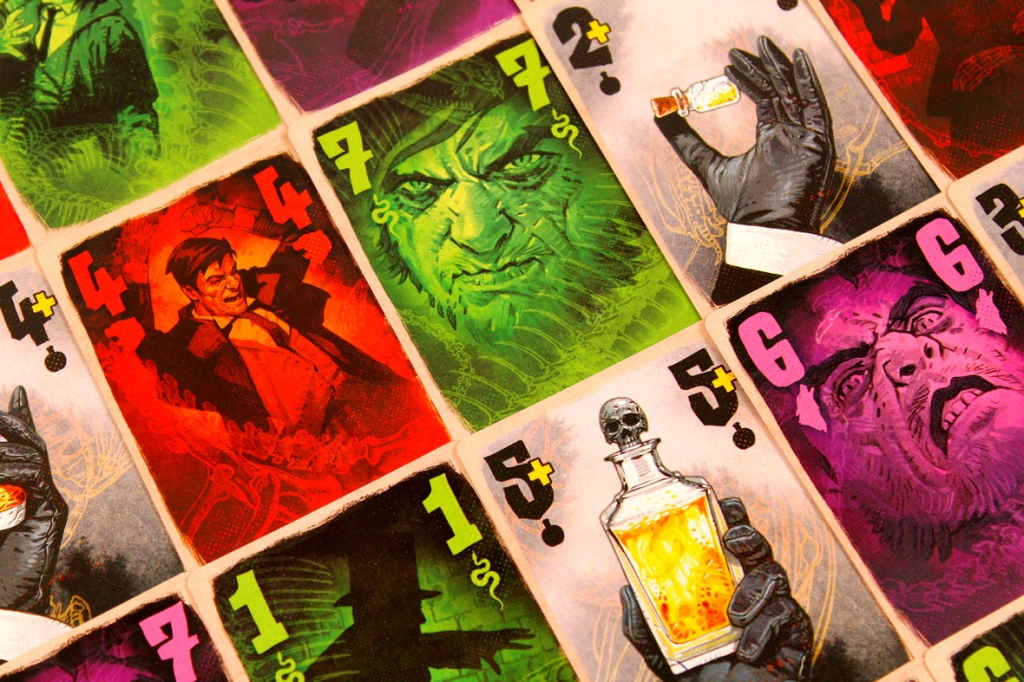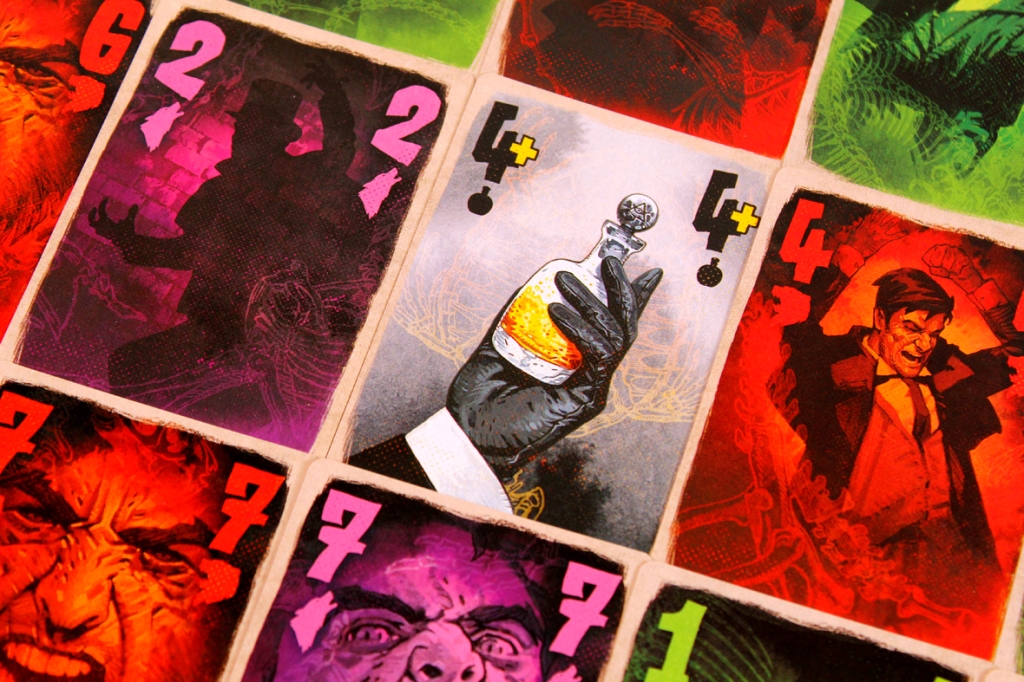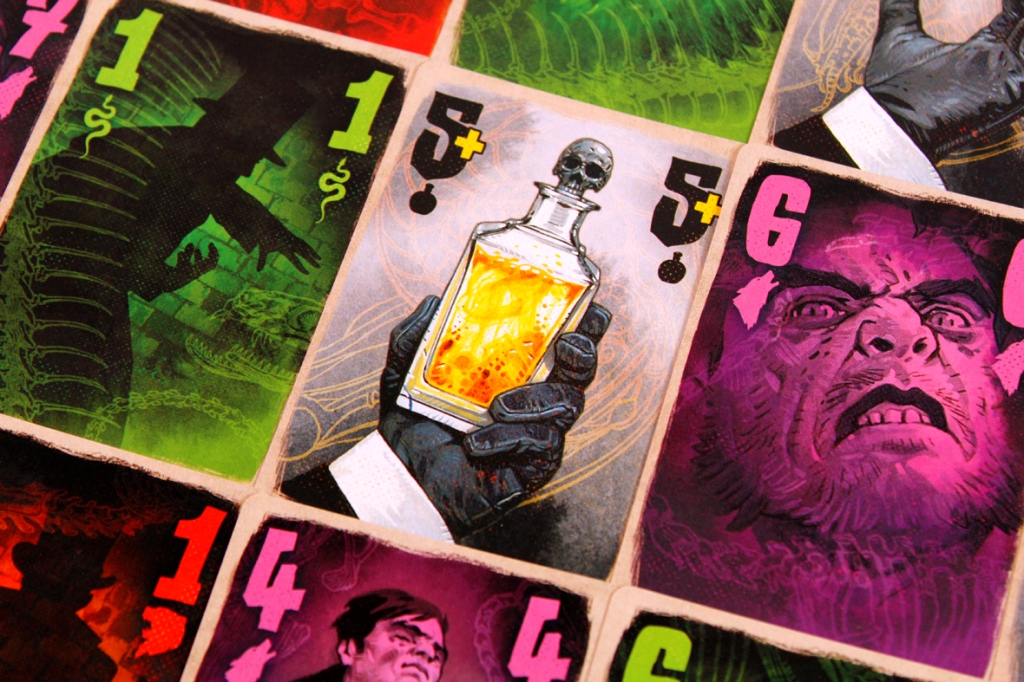
Base price: $23.
2 players.
Play time: ~30 minutes.
BGG | Board Game Atlas
Buy on Amazon (via What’s Eric Playing?)
Logged plays: 6
Full disclosure: A review copy of Jekyll vs. Hyde was provided by Luma Imports.
I’ve been moving towards this review for a while, but it took me a weirdly long time to write? I guess that just happens, sometimes. Every so often you get, like, tantalizingly close to finishing a review, only to just kind of lose steam. It’s part of the reason there are a few partially-done reviews in my queue, or why a full review of Onitama just sits in my buffer somewhere. I liked Onitama; it was just never quite ready for prime time. Regardless, I’m here now, and we’ve got a new two-player trick-taking game to review! I’m surprised that this genre is starting to blossom, a bit; I used to never see two-player trick-taking games, and now there are so many. I’m pleased, and a bit startled, but mostly pleased. So let’s see what Jekyll vs. Hyde has to offer!
In Jekyll vs. Hyde, you’re taking on a study in duality, but in a more hands-on sense. One player is Jekyll, a scientist who has been experiencing a bit of a strange case. The other is Hyde, a rampaging monster who seeks to overwhelm Jekyll and assume full control of your shared body. You’ve heard this story before. If not, well, now you have. Manage evil as Jekyll, or seek imbalance as Hyde. It’s up to you, but only one side can win. Which will it be?
Contents
Setup
Not a ton! One player is Dr. Jekyll, and the other is Mr. Hyde. Set out the board between them:
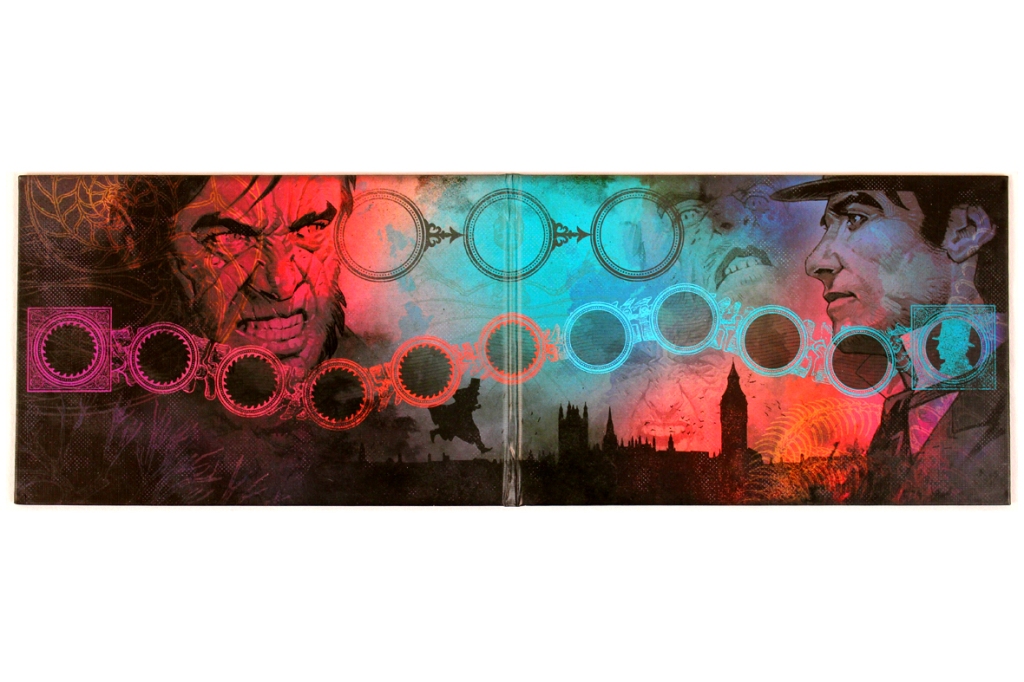
Place the Identity Marker on the blue starting space (on the right side of the board). Set aside the Evil Tokens, for now:
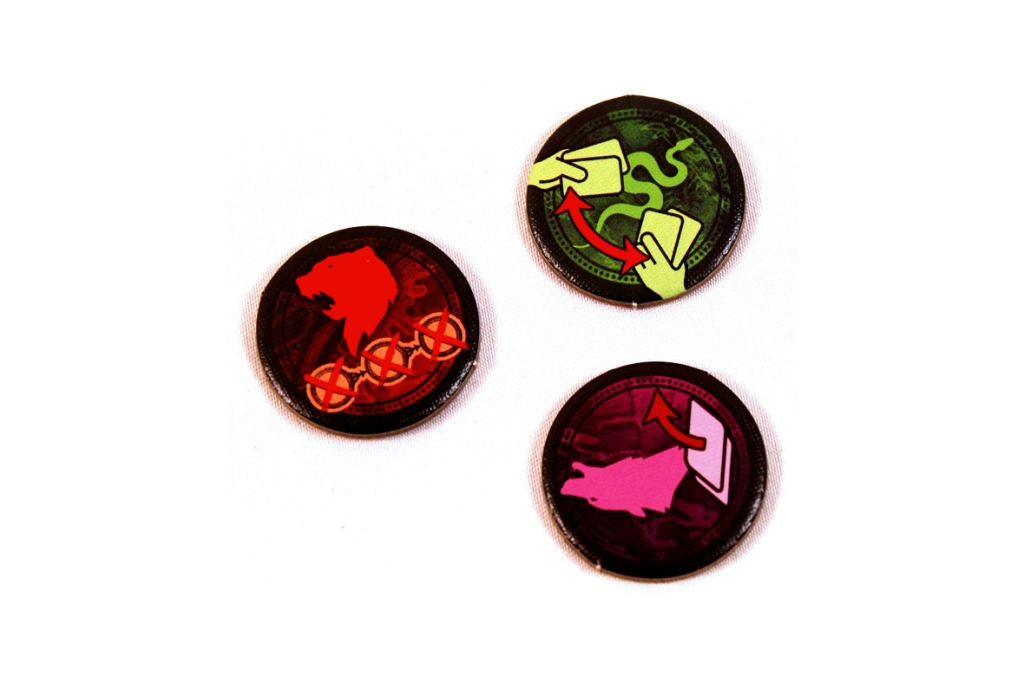
Shuffle the cards together, dealing each player ten (and setting aside the remaining five):
Dr. Jekyll leads the first trick!

Gameplay
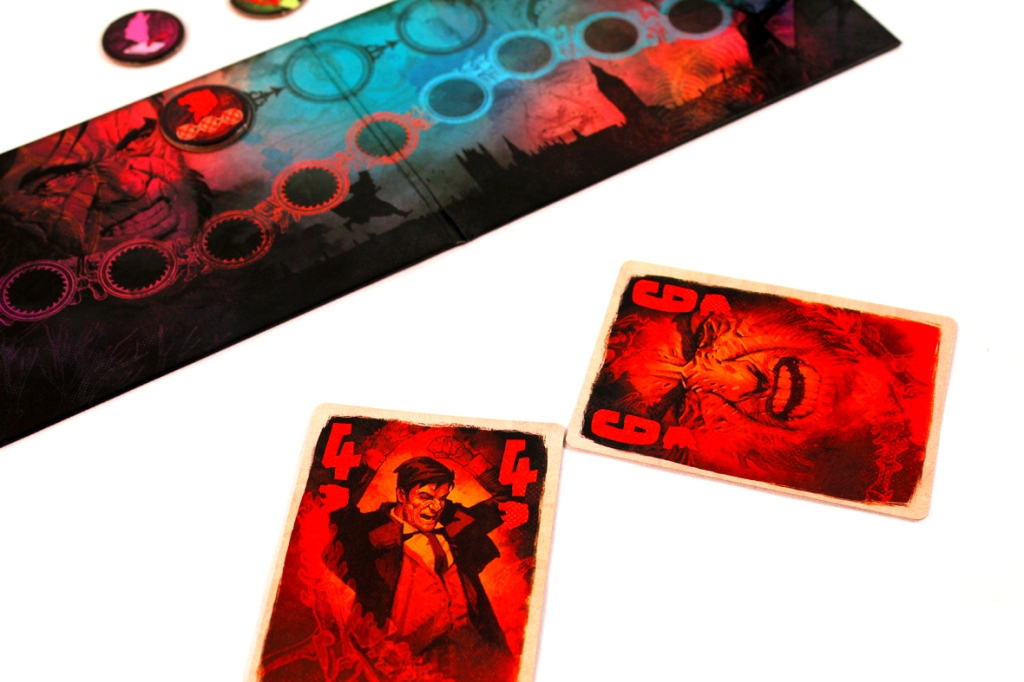
Jekyll vs. Hyde is played over three rounds, as players represent the two halves of Jekyll’s identity fighting for dominance. To start a round, players will swap cards, based on the round number:
- Round 1: Swap one card.
- Round 2: Swap two cards.
- Round 3: Swap three cards.
If you start with two or more Potion Cards, you must include one Potion in your swapped cards. Have fun with that. Once you’ve done that, you’re ready to play a round!
On a turn, both players will play a card from their hand representing a Potion, Pride (Purple), Greed (Green), or Wrath (Red). If the starting player leads with a non-Potion Card, the other player must play the same color or a Potion Card, if they have it. If they don’t have a card of that color, they may play any color card. If the starting player leads with a Potion, they can name a color, and the other player must play a card of that color, if they have it (even if they have a Potion).
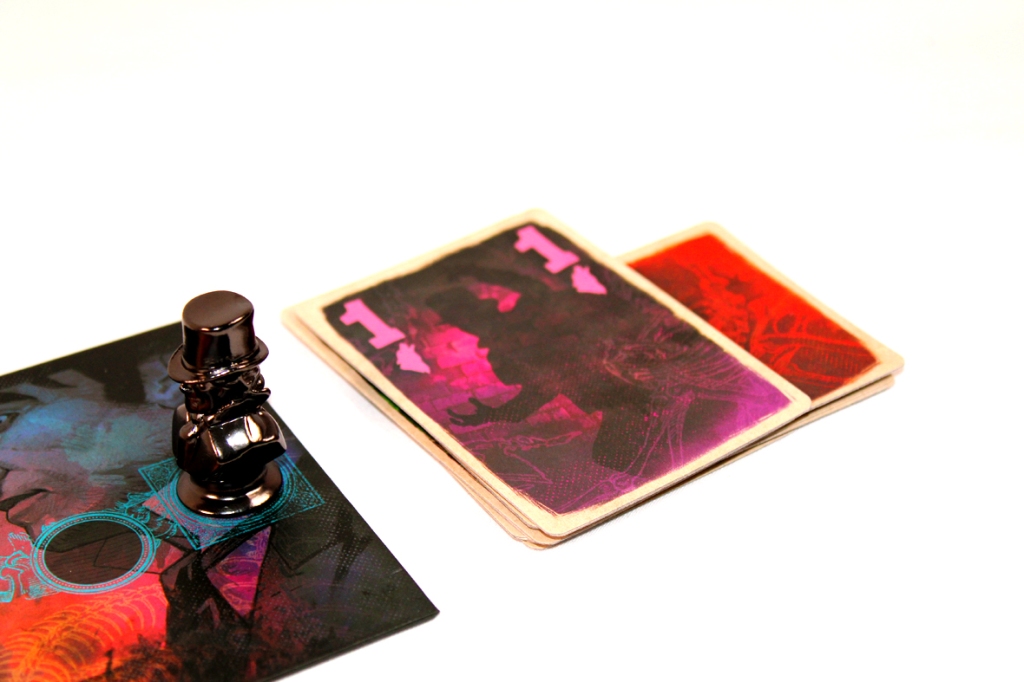
As cards are played, the suits become ranked. The first color to be played in a round is the lowest rank, followed by the second color played, and the third color played is the highest rank. Then, resolve the cards:
- Both cards are the same color: The higher number wins.
- Both cards are different colors: The higher-ranked color wins.
- If either card is a Potion: Resolve the Potion’s effect, then the higher number wins. Recall that all Potion Cards have a + by the number (2+, 3+, 5+, etc), so a 5+ will beat a 5.
Potions have a variety of effects, depending on what color the Evil Card they’re played against is:
- Wrath + Potion: Reset the Evil Token ranking; the next color played will be the lowest suit again, as though you were ranking the cards at the start of the round.
- Greed + Potion: Both players immediately exchange two cards each with each other. If you only have one card left, exchange that card.
- Pride + Potion: The winner of this trick steals a trick from their opponent, adding it to their collection of tricks taken.
If both players play a Potion card, nothing happens; the higher number wins the trick.
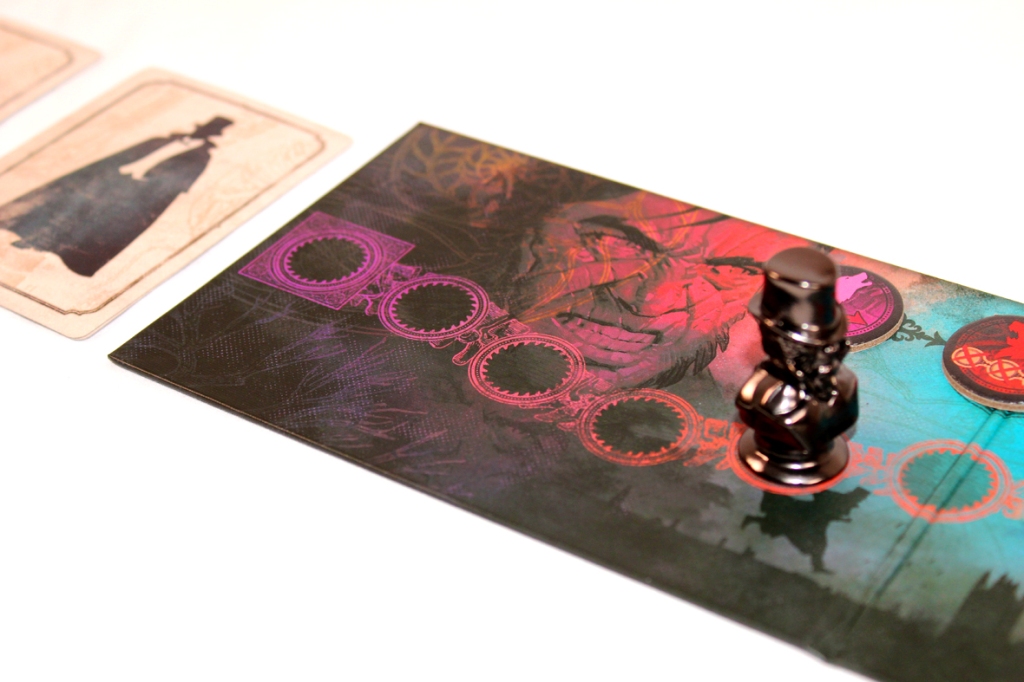
End of Round
At the end of the round, count up the number of tricks won by both players. The difference of those two values is the number of spaces Hyde moves (so if Hyde won 3 tricks and Jekyll won 7, Hyde moves four spaces). Hyde will never move back towards Jekyll, so be careful! Jekyll just needs to keep things balanced.
If Hyde ever reaches the last space of the track, Hyde’s player wins! Otherwise, set up a new round, shuffling back in the cards that were set aside. If Hyde hasn’t reached the end after three rounds, Jekyll’s player wins!
Player Count Differences
None! Exclusively a two-player game.
Strategy
- The card swap at the beginning of each round sets the stage. Plan what your strategy is going to be. If you want to go high or low, plan for that! Just keep in mind that your opponent is going to try and make their own guess, and you may not even be able to choose at all, if you have a bunch of Potions in your starting hand. If that happens, well, aim to use some Green cards + Potions later so that you can get the swap you rightfully deserved.
- Hyde: Commit to winning as many as you can or losing as many as you can, and prep your cards accordingly. You really want to go all low or all high, if you can. It’s even better if you can keep all the red cards and lead them early, so that your opponent can’t use a Potion to reset the hierarchy out from underneath of you. Just be careful! You’ve got Green cards to worry about, and Jekyll can use those with Potions to swap high or low cards into your hand.
- Hyde: Use Potions with Pride to either steal tricks from Jekyll or give tricks to him to keep him off-balance. This is really the lever by which you steal the game (or give it away). Purple cards, when used with Potions, let the winner steal a trick from the loser, so you can use this to offload tricks (or steal some) to tilt the balance one way or the other. You score either way!
- Hyde: Resetting the hierarchy late in a round may help you either win tricks or lose tricks, since Jekyll will have fewer cards left in hand. Players don’t tend to keep a lot of cards of each suit available, so if you reset the card hierarchy late in the round, especially if you lose the trick, Jekyll will lead and play some card that will ultimately be at the bottom of the hierarchy, allowing you to win the rest. That said, if you’re trying to lose tricks, you may want to insert your cards at the bottom of the hierarchy so Jekyll can do nothing but beat you.
- Jekyll: Be careful holding onto Potions until the end of the game; you can goof yourself, if you’re not careful. Holding on to Potions can mean that Hyde may start throwing low-value cards and passing tricks off to you, if you’re not careful. Even if you say Green, if Hyde doesn’t have any Green cards left he can just drop a Purple and suddenly you’ve taken two tricks for the price of one. This can cause your balance to shift pretty aggressively.
- Jekyll: You need to be meticulously keeping track of your opponent’s cards (and yours as well). You should know when you need to win and when you need to lose. Your goal is to preserve balance across the round, so you should win a few tricks and lose others. I generally haven’t seen a strategy of losing five and then winning five … work, but who knows? Maybe it’ll work for you. Either way, you need to be prepared for your opponent to bob and weave pretty aggressively. They’re trying to weasel out of your grasp.
- Jekyll: You don’t need to play a perfect match; you just need to avoid making a huge mistake. It’s (frankly) impressive if you only manage to give up a couple points, and that’s kind of all you need! It’s a ten-point game, so if you only give up two points each round, you win pretty handily! Just make sure you’re not giving up six or eight points in a round; that usually sinks people.
Pros, Mehs, and Cons
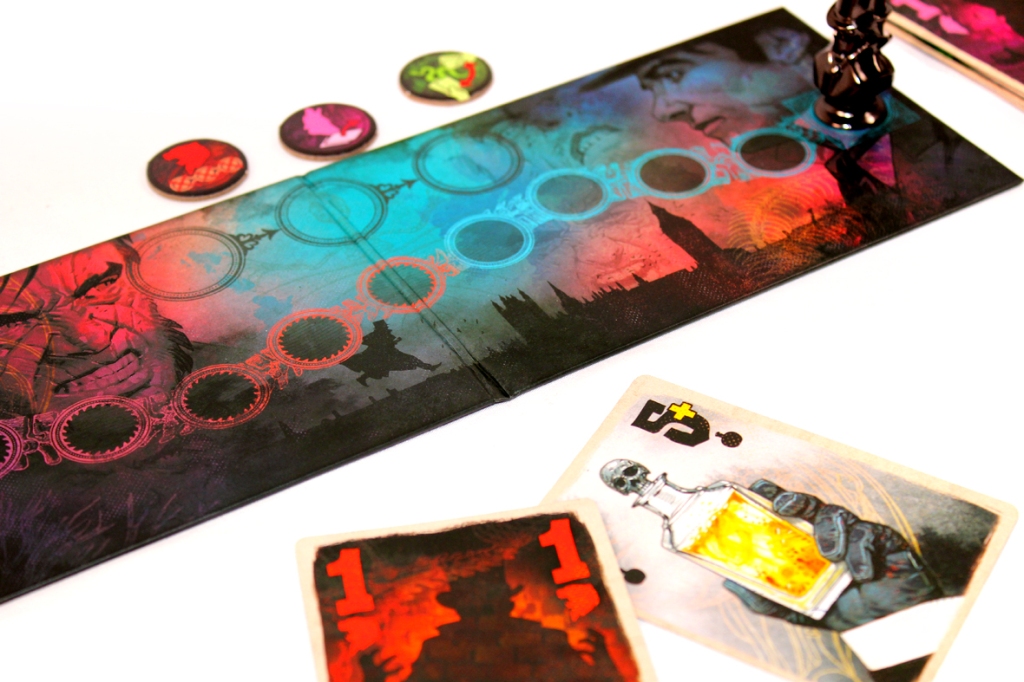
Pros
- This one is tough. I think it’s fascinating, but Jekyll vs. Hyde is definitely one of the harder trick-taking games I’ve played recently. I think the only game I’ve played that was harder was, uh, Oboro Ninja Star Trick. That game was messy; I loved it. Though I’ve called Skull King hard in the past, I’d say it’s more “brutal” than “conceptually difficult to develop a strategy for”. It’s rough if you’re wrong; otherwise, it’s not too bad. This is not just difficult to execute; it’s difficult to understand what the right move is. Fantastic for folks who have played a lot of trick-taking games, though.
- It’s also a very interesting concept! Forcing one player to maintain balance against another player’s complete aggression or their resignation is pretty fun, strategically. I’ve seen games with thresholds, but I haven’t seen one where your goal is to perfectly evenly balance tricks won and tricks lost. It might have been a mission in The Crew. Either way, the asymmetry of the two player roles is super interesting.
- The art style is very cool! Very thematic. I mean, it’s Vincent Dutrait, so not surprising that the game looks good, but the game also has a noted intensity to its art style. It’s aggressive and threatening at every turn, and I think that’s super cool. The cards aren’t Jekyll at all; they’re all Hyde, and managing them is Jekyll’s task. The Potions having different sizes based on their values is just a fun extra feature. The whole game is beautiful, though.
- The looming effect of slowly moving towards Hyde’s total control is fantastic. You cannot move backwards or reclaim lost ground, which makes the game extra threatening. I particularly like that the token is itself two-faced, but I think the game works very hard on matching its theme, its aesthetic, and its gameplay into a fairly seamless experience, and I’m impressed by it.
- I like that the Evil Cards have different effects when combined with Potions. That can really trip you up if you’re not careful, but it’s very cool. It also makes me wonder if there was ever a version of this that had seven different modules: one for each of the deadly sins. That would be a really interesting version to play with (especially if you only ever used three at a time).
- I also really like that leading a Potion allows you to force your opponent to play a specific color, if they have it. You can make a strategy around it, but that requires you to have a pretty encyclopedic knowledge of your opponent’s hand and be willing to take a bit of a risk. You can’t know every card that’s in play, so you have to go off of what you’ve explicitly seen (or what you’re wagering). It’s still a very interesting thing, as usually these kind of blank cards let your opponent play whatever they want, rather than allowing you to draw out a specific color.
- The way that the suits develop a hierarchy as they’re played is fascinating, as well. I like games where you define suit hierarchy dynamically; it keeps things fresh. I’ve seen it done a few times lately, and I’ve been a big fan every time. I’m particularly interested in how you can reset the suit hierarchy in this one; it’s an interesting wrench to throw into the works.
Mehs
- It can be challenging to recover from a bad round (or even a bad call) as Jekyll. You can try and rebound, but if you let Hyde get four or six points in a round, you’re pretty much hosed. I assume better players than I can successfully keep Hyde to a 0-point round, but I haven’t been able to do it, yet. There’s no way to push Hyde backwards, so if you give up some points early, you’d best make sure you don’t give up additional ones in the future. This is particularly odd, since you can only give up an even number of points. This can be addressed a bit if you swap roles after playing a game and compare scores, but in a single game, there’s definitely pressure on Jekyll.
Cons
- I would super not recommend this game as your introduction to trick-taking, especially if you’re playing as Jekyll. There are great games for learning trick-taking, and there are games like this. I still think this is a fun title, but I’d recommend other ways to actually learn trick-taking. If you do choose to learn trick-taking from this game, for some reason, let the other person play Jekyll. Having the responsibility of managing the overall balance of the hand is even more difficult, I think. It’s more exciting, as well, since you’re trying to be an immovable object to your opponent’s unstoppable force, but this isn’t a great learning game.
Overall: 7.25 / 10
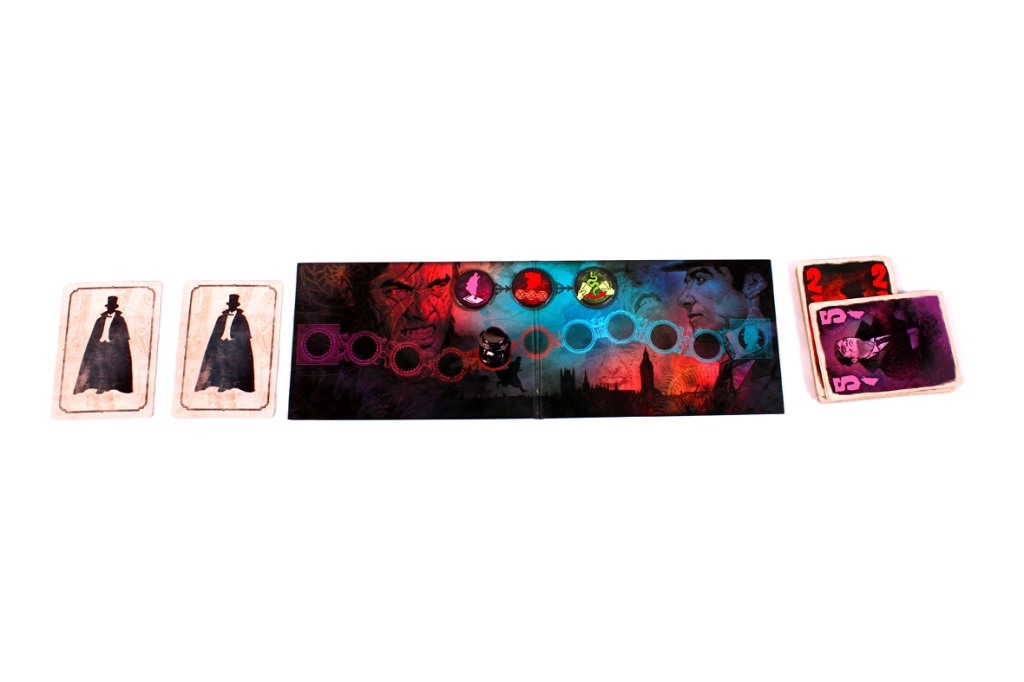
Overall, I think Jekyll vs. Hyde is super interesting! I’m aware (and have mentioned this in the past) that some folks use the word “interesting” as an antonym of the word “good”, but that’s really not the case here. I definitely enjoy playing this, though it’s a bit more advanced than the kind of two-player trick-taking game I tend to enjoy (see: An Otter Won). It’ll appeal to the well-versed in trick-taking, for sure. But I still find the asymmetry of the implementation compelling, and that tends to be the word that bubbles up to the forefront for me. It’s not that “fun” doesn’t; it’s that Jekyll vs. Hyde happens to be so interesting that I tend to be more intrigued by the mechanics when I’m playing (and I’m often struggling to hold on; I made the mistake of challenging my coworker, who is quite skilled at trick-taking, to several rounds of this). There’s definitely room for that in the trick-taking space, and I think folks who want something more intense and cerebral will really enjoy Jekyll vs. Hyde. Me, I tend to stick to the simpler parts of town, though my love for interesting mechanics or novel spins on genres does keep me coming back (as does a pretty robust Board Game Arena implementation). I’d love to see more experimentation happening in the space, but I’m also never going to be disappointed with that Mandoo Games + Vincent Dutrait dream team. If you’re a big trick-taking fan, you love a cerebral game, or you’re interested in going toe-to-toe with a rival for a good challenge, you’ll probably enjoy Jekyll vs. Hyde! I thought it was pretty compelling.
If you enjoyed this review and would like to support What’s Eric Playing? in the future, please check out my Patreon. Thanks for reading!
